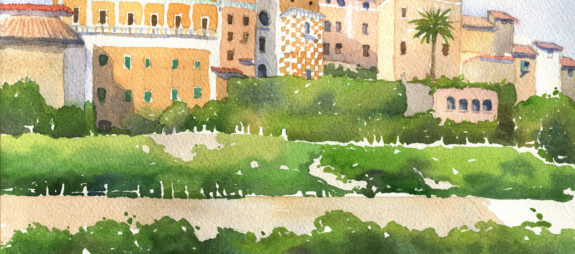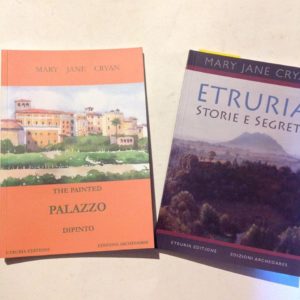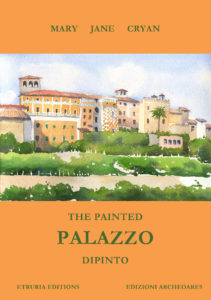The Painted Palazzo -Il Palazzo Dipinto
March 21st, 2017 Tagged with: art history • Ferento • Grand Tour 1900 • history Vetralla • Judith Works • painted palazzo • Piedmont • Pietro Canonica • Vetralla storia
Il Palazzo Dipinto/ The Painted Palazzo is the latest volume about the Tuscia Viterbese by journalist and historian Mary Jane Cryan . It contains new research uncovered in the last few years, in English and Italian for the general public.
^^^^^^^^^^^^^^^^^^^^^^^^^^^^^^^^^^^^^^
FULL COLOR 120 pages, bibliography.
Cost 10 euro
Discounts for schools, language learning associations
Use http://www.elegantetruria.com/contact/ to order.
Payment with paypal or bonifico bancario.
Postage, shipping 2 euro to Italian addresses.
cover art by Kelly Medford
E’ uscito il nuovo libro di Mary Jane Cryan.
E’ la 9° pubblicazione dedicata alla storia e cultura della sua patria d’adozione. In Inglese e Italiano.
Contents Capitoli
The Painted Palazzo-Il Palazzo Dipinto: due famiglie piemontesi – Piatti e Canonica- a Vetralla e nel Lazio: i personaggi, le case, I giardini, i misteri
New Discoveries of art and history in Vetralla-Nuove scoperte d’arte e storia a Vetralla
Foreign Visitors discover Ferento-Come I viaggiatori stranieri hanno visto Ferento
Mysterious Museum Graffitti –Graffitti misteriosi al Museo
Contributi di Susanna Ohtonen, Ruud Hupperts, Maria Giovanna Fadiga e numerosi collezionisti, fotografi e artisti
PREZZO 10 euro Spedizione 2 euro a indirizzi italiani Pagamento con paypal o bonifico bancario
Sconti per multiple copie, per scuole di lingue, per agriturismi, B&B, scuole, associazioni.
^^^^^^^^^^^^
What people are saying about Mary Jane Cryan’s new book “The Painted Palazzo-Il Palazzo Dipinto”
The Painted Palace” by Mary Jane Cryan – review MARGARET STENHOUSE The Italian Insider 19 SEPTEMBER 2019
In “The Painted Palace”, Mary Jane Cryan gives readers a unique insider view of life in the historic town of Vetralla, near Viterbo, and the sprawling former noble residence of the Piatti family, where she has chosen to make her home.
A passionate researcher, Irish-American Cryan traces the story of the lives of former owners and residents of the Palace, a “huge building consisting of 85 rooms on 5 levels and including annexes such as cantinas, gardens, workshops, storage areas, stables and passageways” that included a silk worm breeding area in the servants’ quarters on the attic floor. The Piatti family, industrialists from Piedmont, purchased the Vetralla palace in 1893 and proceeded to restructure it, incorporating several adjoining older houses, a convent and an ancient chapel. As its nickname suggests, the edifice was lavishly frescoed, not only internally, but also externally, on the southern wall overlooking the gardens, with a brown and white checkerboard design and trompe l’oeil archways, balconies and windows.
The author gives us tantalizing glimpses of the lives of the moneyed proprietors, who owned a string of estates and princely homes that included the Bisentina Island on Lake Bolsena, which they transformed into a botanical garden, Villa Carpegna in Rome and their show-piece summer residence, Villa Quittengo in Piedmont, where people like Italian statesman Count Cavour and the popular Italian writer Edmondo De Amicis came for prolonged holidays.
Among the celebrities connected with Palazzo Piatti, Cryan cites the sculptor Pietro Canonica, an artist much in demand among the crowned heads of Europe during the first half of the 20th century, and his adopted daughter, Olga Matteini, an opera singer. She married the Piatti heir, Flaminio, and the couple gambled way the family fortune so that eventually the Vetralla palace had to be sold. Consequently, it was split up into units that included a club for Fascist party members, a nursery school, a refuge for homeless families during the Second World War and, more recently, individual apartments, occupied mainly by foreign residents who appreciate its history and artistic value.
Cryan dedicates a chapter to “the Secret Gardens”, hidden behind the now faded south-facing facade. This is now used for summer concerts, theatrical performances and dinner events.
The concluding chapters focus on lesser known monuments and archaeological sites in the surrounded Tuscia area, like the well-preserved ancient Roman theatre at Ferento (near Viterbo), the mysterious stone figures scattered around various sites and the Etruscan sphinx discovered at Vulci a few years ago.
Most intriguing of all Cryan’s “discoveries” is the “Boston Michelangelo” – a little fresco discovered in a niche in the Vetralla Church of San Pietro during restoration work. This mirrors a drawing of a “Pietà” that the Renaissance genius is believed to have made for either Vittoria Colonna or Cardinal Reginald Pole. The original is in the Isabella Stewart Gardner Museum of Boston.
“The Painted Palace” (in English with Italian translation) follows Cryan’s other books dedicated to the Tuscia ( Etruria) area including “Etruria Travel, history and Itineraries in Northern Lazio”, “The Irish and English in Italy’s Risorgimento”, “Affreschi Exploring Etruria”, a collection of essays written with Norman M. Roberson, “Vetralla the English Connection” and “Travels to Tuscany and Northern Lazio”, documenting the pastoral visits to the Tuscia area in the 18th century by Cardinal Henry Stuart, last of the Stuart line, who brought many benefits to the town and whose bust can be seen in Vetralla Town Hall and “Etruria Storie e Segreti” (in Italian).
The Painted Palace is published by Etruria Editions and Edizioni Archeoares. 120 pages. €5.99-€10
^^^^^^^^^^^^^^^^^^^^^^^
I have just read your book “Palazzo dipinto”. Reading was interesting and flowing. All the sections (Piatti family, Canonica, Ferento,..) are brimful of enthralling descriptions and anectodes. There is so much work, research and dedication behind it! Edoardo Virgilio
la ringrazio di avermi inviato una copia del bel volume sulla storia di Palazzo Piatti e Vetralla. Un interessante contributo che ricostruisce la storia della famiglia Piatti/Canonica a Vetralla e gli affascinanti siti archeologici del viterbese. Narrativo e coinvolgente è stato veramente gradevole leggerlo. Complimenti per questo suo lavoro. Fabiola Polsinelli, Museo Canonica, Roma
Grazie a Mary Jane che con il suo bel libro ha ritrovato un pezzo di storia di Vetralla ormai dimenticato ma importante. E’ un libro scorrevole, piacevole da leggere, ben scritto e ben illustrato.
Fabrizio Moracci, Vetralla
Ho appena finito di leggere il tuo nuovo libro sulla storia della famiglia Piatti nonchè i suoi legami con Canonica. Le notizie che hai reperito e pubblicato sono inedite e veramente interessanti per chi studia non solo la storia di Vetralla ma anche per chi fa ricerche su Pietro Canonica. Spero che anche i Vetrallesi apprezzeranno questo tuo contributo. Complimenti di cuore ! Cristina Delvecchio, Museo di Roma
Just to thank you for your latest publication. I must say that the attractive cover makes Vetralla look very exotic, even North African! You are, by now, Vetralla’s most published historian. Well done,
John Ferro Sims, photographer, UK
Oggi ho dedicato il mio pomeriggio alla lettura e ho iniziato a leggere “ Palazzo dipinto “ di Mary Jane Cryan . Quello che mi ha molto colpito è la semplicità di scrittura unita alla sua grande e accurata ricerca su alcune Famiglie e i luoghi Vetrallesi . Il libro mi ha coinvolto e trascinato come per incanto in un mondo, che non è mio per nascita ma lo sento nel mio cuore, di particolari e di eventi per cui le scene prendevano forma davanti a i miei occhi. Una “ Perla “ quella di Mary Jane Cryan che arricchisce ulteriormente la Città di Vetralla . Il mio pensiero non ha pretesa di critica ma solo un plauso per un libro che mi ha dato gioia nel leggerlo. Giovanni Diodato, Movimento Artistico, Vetralla
Historian and writer Mary Jane Cryan takes the reader on another excellent tour of several lesser-known sites tucked away in northern Lazio. The short book, written in both Italian and English, is ideal for those learning Italian, and for tourists who are interested in delving deeper into the complex layers of history of this small part of Italy so close to Rome.
Ms. Cryan uses the Piatti family as her springboard for her stories. They were the former owners of a palazzo in Vetralla where she herself now lives. Early postcards of Vetralla show the town dominated by an enormous building consisting of 85 rooms on five levels along with outbuildings. This is the Palazzo Piatti, purchased by the family in 1903. Its origins are unknown but probably medieval. One can only imagine the original builders.
The Piatti were builders and engineers originally from the Piedmont, who played a large part in the development of railroads in Italy from the mid-19th century to the early 20th. They became wealthy property owners, purchasing villas in the Piedmont, Subiaco and Rome, as well as more than 5000 hectares of land around Viterbo and Vetralla.
The family favored a style of decoration from Liguria, the interior painted with floral design, examples of which remain along with scraps of other frescoes so evocative of Lazio with its cypress and umbrella pines. The exterior was a mix of tromp l’oeil and checkerboard, unfortunately now gone as are the servants and workers who must have maintained the establishment. But the palazzo itself survived, serving as barracks during World War I, and as a second home for the famous sculptor Pietro Canonica, when his daughter married one of the heirs to the Piatti fortune. But time and the forces of history never rest. Portions of the building were sold off beginning in 1929 because of gambling debts, and by 1939 the remainder passed from the family hands. Parts of it were used as a club for Fascist family members, then living quarters for homeless families during and after the war.
The wheel of fortune turned again with new owners who appreciate the remaining frescos and who have put their energies into restoration. One couple have rebuilt the gardens and a portion of the building to be used for musical performances put on by OperaExtavaganza.
The Piatti family had an impact on other properties in the area including the island of Bisentina floating on Lake Bolsena. One of the Piatti brothers owned it from 1899 to 1912 and was responsible for the restoration of a crumbling monastery and establishing the botanic gardens. Yet another overlooked site to go on my “To Visit” list.
The second half of the book consists of vignettes about new discoveries and locations worth a visit – who wouldn’t want to see Easter Island sculptures in the tiny hill town of Vitorchiano? I was particularly interested in the ruins located at Ferento, the Roman city of Ferentium, as seen through the eyes of travelers in the 18th century and early 20th. It was inhabited until the Middle Ages when the good citizens of Viterbo reportedly destroyed it over the offense of a crucifix designed with Christ’s eyes open instead of shut. Now it’s a little-visited archeological site hosting an amphitheater and a few other semi-ruined buildings. The Roman road running through the town is rutted with cart tracks and I wondered if travelers passed by the Palazzo Piatti on their way to visit before moving on to Rome.
One of these travelers to the site, James Sully, recorded his impressions of the area after he visited Ferento. In a book published in 1912, he sniffed. “He will do well to visit other towns which had hostile doings with Viterbo: …Vetralla where, though there is little of interest in the squalid-looking town, he may walk over to the romantic Valley of Norchia, and see the long series of lofty, temple-like Etruscan tombs carven on the face of the warm yellow cliffs.”
Well, now we know he was wrong. If only he’d had this entertaining book in hand he’d have had a far better impression.
Review by Judith Works
author Coins in the Fountain – a Midlife Escape to Rome.
https://www.judithworks.net/about-judith
What people are saying about Mary Jane Cryan’s new book “The Painted Palazzo”
Mary Jane Cryan always manages to find some fascinating pieces of history regarding Etruria hidden away in some foreign archive, disclosing both new important historical and interesting information.
This time, she has read through the walls of a painted palazzo in Vetralla uncovering its fascinating history through the life of its owners: a millionaire and his wife, who happens to be the adoptive daughter of artist Pietro Canonica.
Through the painted walls of the Palazzo, we trace back not only the history of its paintings and the palace itself, but the whole family that owned it, uncovering new details of the artist Pietro Canonica’s everyday life in Vetralla.
There is so much history and so many secrets to be yet discovered in Tuscia, and Mary Jane does a great job uncovering some of them, while at the same time, entertaining the readers and inflaming their curiosity to the point that they are left wondering what she will discover next and looking forward to her next quest.
Chloé V. Ercoli Bannister,
archeologist, professor at Istituto Lorenzo de’ Medici
Mary Jane Cryan riesce sempre a trovare qualche pezzo di storia affascinante riguardante l’Etruria, nascosta in qualche archivio straniero, rivelando nuove importanti informazioni storiche e di notevole interesse. Questa volta, ha letto tra le pareti di un palazzo dipinto a Vetralla, scoprendo la sua affascinante storia attraverso la vita dei suoi proprietari: un milionario e sua moglie, che il caso ha voluto fosse la figlia adottiva dell’artista Pietro Canonica.
Attraverso le pareti dipinte del Palazzo, leggiamo non solo la sua storia, ma anche quella di tutta la famiglia che l’ha posseduto, scoprendo nuovi dettagli sulla vita quotidiana Vetrallese dell’artista Pietro Canonica.
Tanta storia e tanti segreti sono ancora da scoprire nella Tuscia, e Mary Jane fa un ottimo lavoro portandone alcuni alla luce, e allo stesso tempo intrattenendo i lettori e infiammando la loro curiosità al punto che ci si chiede quale sarà la sua prossima ricerca.
Chloé V. Ercoli Bannister,
archeologist, professor at Istituto Lorenzo de’ Medici


